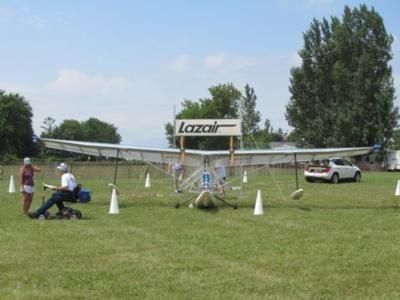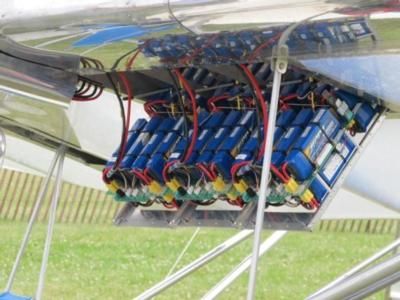Tue, Jul 26, 2011
Off-The-Shelf-RC-Technology Powers Electric Ultralight
By Gene Yarbrough
While necessity may be the mother of invention, some innovate
just because the challenge is there, and converting a hydrocarbon
powered flying machine to electric based propulsion with off the
shelf R/C airplane technology is no small feat. Enter Dale Kramer,
famous designer and inventor of the venerable Lazair Ultralight'
circa 1980's.

Electric powered airplanes are all the rage, evidenced by an
entire symposium on the subject at this years’ EAA
Airventure, however (and despite some mighty fine minds working on
the problem) it remains elusive thus far as a largely viable means
of flight. Regardless, as many times is the case, as technology
comes upon the cusp of feasibility an innovator applies such to a
minimal system to realize the most rudimentary demonstration. Dale
Kramer has applied off the shelf radio control model airplane
battery, motor, and controller technology to a Lazair airframe to
create the first electric powered amphibious ultralight conforming
to 14CFR Part 103 regulations.

According to
Kramer's postings on an RC group message
board, he anticipated achieving flights of up to two hours
solely powered by on board battery packs and expects longer flights
while soaring and thermaling the Lazair. Real world results have
been a bit less than expected with flights of an hour and fifteen
minutes without the float gear, but the learning curve is still in
play. While recharging is a bit of a hassle, requiring electric
service or a generator or two compared to simply refilling a gas
tank, the electrics are expectedly more efficient from an energy
usage standpoint and will undoubtedly prove to be more advantageous
to gasoline engines as battery technology progresses with better
power density ratios. Typical "refills" cost about a dollar or so
when coming off the power grid or about four dollars per flight
hour from the generators as compared to around eight dollars per
flight hour at current gas prices. The lithium polymer batteries
Kramer is using are completely off the shelf units numbering 96
packs and are the same as those used in typical R/C electric
powered model airplanes, along with the motors and motor
controllers. Electrics are still a bit pricey, on the order of
about twice the cost of the original 2 stroke engines.

Kramer has fitted all these components onto an existing Lazair
airframe with longer nacelles and other minimal modifications to
offset the CG change from the gas engines. Initial tests have shown
the E-Lazair, for lack of a better term, to be quite adequately
powered and gives comparable performance to its petrol counterpart.
While Kramer has operated the E-Lazair from both land and water
with amphibious floats, the success has been co-mingled with
setbacks and challenges as is all too often the case in pushing the
technological envelope. Thus far, according to Kramer, he has fried
motor controllers, two motors, and/or associated parts while
discovering that employing electrons to do your bidding comes with
caveats. However, true to Kramer and most innovators, perseverance
has prevailed. Dale is at Airventure this year already inundated
with queries of all sorts reminiscent of the Lazair heydays of the
mid eighties.

Electricity may be the future of recreational aviation as
gasoline becomes passe’ and environmental sensitivities
demand a re-think in propulsive systems. This endeavor has shown
that the technology has matured sufficiently to enter the
marketplace. Much as the automotive industry has adopted the
paradigm shift aviation is set to follow suit with several big name
manufacturers eyeballing electric powerplants and several smaller
projects coming online.
FMI: www.rcgroups.com/forums/showthread.php?t=1412424&page=1
More News
Aero Linx: International Business Aviation Council Ltd IBAC promotes the growth of business aviation, benefiting all sectors of the industry and all regions of the world. As a non->[...]
"During the annual inspection of the B-24 “Diamond Lil” this off-season, we made the determination that 'Lil' needs some new feathers. Due to weathering, the cloth-cove>[...]
Also: Bushcat Woes, Hummingbird 300 SL 4-Seat Heli Kit, Carbon Cub UL The newest Junkers is a faithful recreation that mates a 7-cylinder Verner radial engine to the airframe offer>[...]
Also: Seaplane Pilots Association, Rotax 916’s First Year, Gene Conrad After a decade and a half of struggling with the FAA and other aero-politics, G100UL is in production a>[...]
Also: Martha King Scholarship, Montaer Grows, Textron Updates Pistons, FlySto The FAA is hiring thousands of air traffic controllers, but the window to apply will only be open for >[...]
 ANN's Daily Aero-Linx (04.16.24)
ANN's Daily Aero-Linx (04.16.24) Aero-News: Quote of the Day (04.16.24)
Aero-News: Quote of the Day (04.16.24) Airborne 04.10.24: SnF24!, A50 Heritage Reveal, HeliCycle!, Montaer MC-01
Airborne 04.10.24: SnF24!, A50 Heritage Reveal, HeliCycle!, Montaer MC-01 Airborne 04.12.24: SnF24!, G100UL Is Here, Holy Micro, Plane Tags
Airborne 04.12.24: SnF24!, G100UL Is Here, Holy Micro, Plane Tags Airborne-Flight Training 04.17.24: Feds Need Controllers, Spirit Delay, Redbird
Airborne-Flight Training 04.17.24: Feds Need Controllers, Spirit Delay, Redbird






